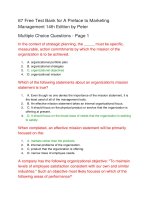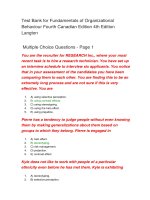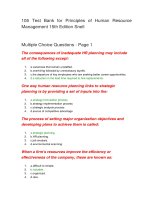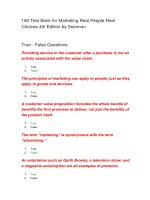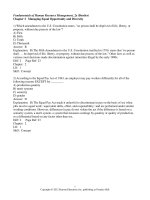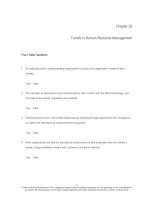Test bank for fundamentals of human resource management 4th edition by noe
Bạn đang xem bản rút gọn của tài liệu. Xem và tải ngay bản đầy đủ của tài liệu tại đây (218.44 KB, 75 trang )
Full file at />
Chapter 01
Managing Human Resources
True / False Questions
1. Managers and economists traditionally have seen human resource management as a source
of value to their organizations.
True False
2. The concept of "human resource management" implies that employees are interchangeable,
easily replaced assets that must be managed like any other physical asset.
True False
3. Human resources cannot be imitated.
True False
4. No two human resource departments will have precisely the same roles and
responsibilities.
True False
5. Today, greater concern for innovation and quality has shifted the trend in job design to an
increased use of narrowly defined jobs.
True False
6. An organization makes selection decisions in order to add employees to its workforce, as
well as to transfer existing employees to new positions.
True False
buy this full document at
Full file at />
7. In the context of performance management, when the person evaluating performance is not
familiar with the details of the job, outcomes tend to be easier to evaluate than specific
behaviors.
True False
8. The pay and benefits that employees earn play an important role in motivating them, except
when rewards such as bonuses are linked to the individual's or group's achievements.
True False
9. Maintaining positive employee relations includes preparing and distributing employee
handbooks that detail company policies and, in large organizations, company publications
such as a monthly newsletter or a Web site on the organization's intranet.
True False
10. Establishing and administering personnel policies allows the company to handle
problematic situations more fairly and objectively than if it addressed such incidents on a
case-by-case basis.
True False
11. Currently, no federal laws outline how to use employee databases in order to protect
employees' privacy while also meeting employers' and society's concerns for security.
True False
12. Human resource management is increasingly becoming a purely administrative function.
True False
13. Evidence-based HR refers to the practice of initiating disciplinary action against
employees only in the presence of clear and demonstrable proof of undesirable behavior.
True False
buy this full document at
Full file at />
14. Corporate social responsibility describes a company's commitment to meeting the needs
of its stakeholders.
True False
15. To carry out the functions of talent manager/organizational designer effectively, an HR
manager must possess knowledge of how the organization is structured and how that structure
might be adjusted to help it meet its goals for developing and using employees' talents.
True False
16. All HR skills require some ability as operational executor.
True False
17. In contrast to those in smaller organizations, supervisors in larger firms need not be
familiar with the basics of HRM.
True False
18. Recent surveys indicate that managers have largely positive perceptions of the ethical
conduct of U.S. businesses.
True False
19. According to the right of privacy, employers can conceal the nature of the job before
hiring an employee.
True False
20. Mimi feels that her being denied promotion has more to do with her being a woman than
with her performance. However, her supervisors and the HR department are refusing to hear
her case. This indicates that Mimi has been denied her right to due process.
True False
buy this full document at
Full file at />
21. In ethical, successful companies, the owners, not the employees, assume responsibility for
the actions of the company.
True False
22. For human resource practices to be considered ethical, they must result in the greatest
good for the largest number of people.
True False
23. The role of HR generalist is mostly limited to recruitment and selection.
True False
24. The vast majority of HRM professionals have a college degree.
True False
25. Some HRM professionals are members of professional associations, but many more have
a professional certification in HRM.
True False
Multiple Choice Questions
26. The policies, practices, and systems that influence employees' behavior, attitudes, and
performance constitute:
A. supply chain management.
B. materials management.
C. human resource management.
D. labor laws.
E. equal employment opportunity.
buy this full document at
Full file at />
27. Managers and economists traditionally have seen human resource management as:
A. a source of value to their organization.
B. a necessary expense.
C. an asset.
D. an essential component of a high-performance work system.
E. a waste of money.
28. The concept of "human resource management" implies that employees:
A. are interchangeable.
B. are easily replaceable.
C. are a necessary expense.
D. can add economic value to the organization.
E. are not crucial to the company's success or failure.
29. As a type of resource, human capital refers to:
A. the wages, benefits, and other costs incurred in support of HR functions in an organization.
B. executive talent within an organization.
C. the tax-deferred value of an employee's 401(k) plan.
D. employee characteristics that add economic value to the organization.
E. the total budget allocated to the HR department in an organization.
30. Human capital includes all of the following EXCEPT:
A. training.
B. profitability.
C. relationships.
D. intelligence.
E. insight.
buy this full document at
Full file at />
31. When an organization is better than competitors at something and can hold that advantage
over an extended period of time, it is said to have a(n):
A. differentiated focus.
B. sustainable competitive advantage.
C. core competency.
D. low-cost competitive advantage.
E. optimum efficiency frontier.
32. The text implies that human resources that are valuable, rare, inimitable, and hard to
replace contribute to an organization achieving:
A. only short-term success.
B. low employee turnover.
C. low client retention rates.
D. low recruitment costs.
E. a sustainable competitive advantage.
33. Human resources provide an organization with a sustainable competitive advantage
because:
A. highly skilled and knowledgeable employees are commonly available.
B. the organization can easily duplicate the success of competitors' human resources.
C. after financial resources, human resources are the most committed to an organization.
D. high-quality employees provide a needed service as they perform many critical functions.
E. employees can be easily trained, motivated, and developed to care about customers.
34. Which of the following terms describes an organization in which technology,
organizational structure, people, and processes all work together to give an organization an
advantage in the competitive environment?
A. Low-involvement work system
B. Optimal production system
C. Balanced score-card system
D. Environmental work system
E. High-performance work system
buy this full document at
Full file at />
35. On average, an organization has one HR staff person for every _____ employees served
by the department.
A. 15
B. 27
C. 54
D. 93
E. 145
36. According to the text, administrative services and transactions, business partner services,
and strategic partner, all constitute:
A. activities usually outsourced by large organizations.
B. the responsibilities of HR departments.
C. tasks carried out by supervisors in most companies.
D. functions of the top management in large companies.
E. HR activities usually carried out by line managers in large companies.
37. If one were to think of HR as a business, which of the following "product lines" involves
developing effective HR systems that help the organization meet its goals for attracting,
keeping, and developing people with the skills it needs?
A. Administrative services
B. Business partner services
C. Strategic partner
D. Product quality audit
E. Administrative transactions
38. Which one of the following responsibilities is specifically associated with the HR function
of employee relations?
A. Conducting attitude surveys
B. Work analysis
C. HR information systems
D. Human resource planning and forecasting
E. Job design
buy this full document at
Full file at />
39. Which of the following responsibilities is specifically associated with the HR function of
support for strategy?
A. Discipline
B. Human resource planning and forecasting
C. Wage and salary administration
D. Developing employee handbooks and company publications
E. Developing an HR information system
40. Which of the following refers to the process of getting detailed information about jobs?
A. Job design
B. Workflow analysis
C. Job analysis
D. Work study
E. Job review
41. Job design is the process of:
A. defining the way work will be performed and the tasks that a given job requires.
B. the process of getting detailed information about jobs.
C. the process by which the organization attempts to identify suitable candidates for jobs.
D. enabling employees to learn job-related knowledge, skills, and behavior.
E. presenting candidates with positive and negative information about a job.
42. At Smartech, a company dealing in software products, employees often complain about
lack of clarity regarding the tasks they are required to perform. Specifically which HR
function, it would appear from this information, has been performed inefficiently at
Smartech?
A. Compliance with laws
B. Analysis and design of work
C. Compensation and benefits
D. Maintaining employee relations
E. Recruitment and selection
buy this full document at
Full file at />
43. Why has the job trend shifted to broadly defined jobs?
A. Emphasis on innovation and quality
B. Increased demand for low skilled workers
C. Increased focus on simplifying jobs
D. Lack of competition
E. Increased need for efficiency
44. Which of the following refers to the process through which an organization seeks
applicants for potential employment?
A. Orientation
B. Selection
C. Recruitment
D. Work analysis
E. Job design
45. The process by which the organization attempts to identify applicants with the necessary
knowledge, skills, abilities, and other characteristics that will help the organization achieve its
goals is referred to as:
A. orientation.
B. selection.
C. recruitment.
D. work analysis.
E. performance management.
46. According to a study quoted in the text, which of the following is one of the top qualities
that employers say they are looking for in employees?
A. Physical skills
B. Wide experience
C. Computer skills
D. Multilingual skills
E. Interpersonal skills
buy this full document at
Full file at />
47. According to a study quoted in the text, which one of the following is NOT among the top
qualities employers look for in employees?
A. Computer skills
B. Work ethic
C. Initiative/flexibility
D. Honesty/loyalty
E. Interpersonal skills
48. _____ is a planned effort to enable employees to learn job-related knowledge, skills, and
behavior.
A. Selection
B. Employee relations
C. Training
D. Coordinating
E. Recruitment
49. The HR function of _____ involves acquiring knowledge, skills, and behavior that
improve employees' ability to meet the challenges of a variety of new or existing jobs,
including the client and customer demands of those jobs.
A. recruitment
B. personnel policy
C. development
D. employee relations
E. selection
50. If a company, as part of its job redesign program, plans to set up teams to manufacture
products, which of the following programs might it offer to help employees learn the ins and
outs of effective teamwork?
A. Development
B. Recruitment
C. Orientation
D. Selection
E. Performance management
buy this full document at
Full file at />
51. The process of ensuring that employees' activities and outputs match the organization's
goals is called:
A. job analysis.
B. strategic management.
C. employee development.
D. performance management.
E. career planning.
52. Which of the following is an example of an outcome that can be used to evaluate
performance?
A. The manner in which a customer complaint is addressed
B. The method used to assemble a product
C. The order in which a series of tasks is performed
D. The number of customer complaints
E. The tone used in speaking to subordinates
53. Which one of the following is NOT true of the performance management process?
A. Performance measures may emphasize either observable behaviors or outcomes, or both.
B. The evaluation may focus on the short term or long term.
C. When the person evaluating performance is not familiar with the details of the job, specific
behaviors tend to be easier to evaluate than outcomes.
D. In some organizations, employees evaluate their own performance, and often, peers and
subordinates participate, too.
E. The evaluation may focus on individual employees or groups.
54. Typically, the evaluation in performance management is completed by:
A. HR specialists.
B. external job analysts.
C. the incumbent employee.
D. peers and subordinates.
E. the employee's supervisor.
buy this full document at
Full file at />
55. The employees at Edifice Financials complain that they are not provided feedback on their
performance. They do not get proper information as to how they have performed and where
they need to improve. The performance goals are vague and not measurable. Which HR
function does Edifice Financials need to improve upon?
A. Recruitment and selection
B. Employee relations
C. Training and development
D. Performance management
E. Planning and administering pay and benefits
56. This HR function includes preparing and distributing employee handbooks that detail
company policies and, in large organizations, company publications such as a monthly
newsletter or a Web site on the organization's intranet.
A. Recruitment and selection
B. Maintaining positive employee relations
C. Ensuring compliance with labor laws
D. Performance management
E. Planning and administering pay and benefits
57. When employees of an organization feel they have been discriminated against, see safety
hazards, or have other problems and are dissatisfied with their supervisor's response, they may
turn to the HR department for help. Addressing such problems suitably is part of the HR
function of:
A. recruitment and selection.
B. maintaining positive employee relations.
C. training and developing employees.
D. performance management.
E. planning and administering pay and benefits.
58. The HR function of maintaining positive employee relations includes:
A. maintaining performance measures on outcomes.
B. offering training programs on effective teamwork.
C. selecting only those applicants that are referred by employees.
D. maintaining communication with union representatives.
E. planning employee pay and benefits.
buy this full document at
Full file at />
59. How does establishing and administering policies help organizations?
A. It allows companies to handle situations fairly and objectively.
B. It allows companies to address issues on a case-by-case basis.
C. It eliminates documentation and record-keeping.
D. Employees are not told of the consequences of violating the policies.
E. It leaves a lot of room for subjective decision-making.
60. Labor laws:
A. guarantee lifetime employment.
B. prohibit employment at will.
C. prohibit layoffs.
D. prohibit age discrimination.
E. do not govern pay and benefits.
61. Under the principle of "employment at will", the employer may terminate employment:
A. after two weeks' notice.
B. at any time without notice.
C. immediately after written notice.
D. only if the employee voluntarily resigns.
E. only if he can show just cause.
62. Evidence-based HR refers to:
A. the exclusive use of statistical models for planning, forecasting, and other related HR
activities.
B. the establishment of measurable performance goals and desired outcomes during
performance management.
C. demonstrating that human resource practices have a positive influence on the company's
profits or key stakeholders.
D. the process of ensuring that employees' activities and outputs match the organization's
goals.
E. an organization-wide planned effort to enable employees to learn job-related knowledge,
skills, and behavior.
buy this full document at
Full file at />
63. The process of identifying the numbers and types of employees the organization will
require in order to meet its objectives is known as:
A. supply chain management.
B. performance management.
C. human resource planning.
D. work analysis.
E. performance planning.
64. This process helps the human resource department to forecast the organization's needs for
hiring, training, and reassigning employees, and also includes handling or avoiding layoffs.
A. Supply chain management
B. Job development
C. Human resource planning
D. Evidence-based HR
E. Corporate social responsibility
65. Which of the following describes a company's commitment to meeting the needs of its
stakeholders?
A. Corporate governance
B. Public relations
C. Social media optimization
D. Public governance
E. Corporate social responsibility
66. The parties with an interest in the company's success—typically, shareholders, the
community, customers, and employees—constitute the _____ of a company.
A. market
B. stakeholders
C. management
D. personnel
E. strategic partners
buy this full document at
Full file at />
67. Ensuring a fair return on investors' capital, safe and reliable products for customers, fair
compensation and safe working conditions for employees, and clean air and water for
communities, are all ways in which a company can exercise:
A. public relations.
B. social networking.
C. corporate social responsibility.
D. social media optimization.
E. corporate governance.
68. An HR manager becomes a(n) _____ when she is so well respected in the organization
that she can influence the positions taken by managers. This involves delivering results with
integrity, sharing information, building trusting relationships, influencing others, providing
candid observation, and taking appropriate risks.
A. credible activist
B. cultural steward
C. strategic architect
D. operational executor
E. business ally
69. In the role of a cultural steward, an HR manager:
A. administers day-to-day work of managing people.
B. helps employees find meaning in their work and manage work/life balance.
C. develops people strategies that contribute to the business strategy.
D. understands how the business makes money.
E. recognizes business trends and their impact on the business.
70. As ___, the HR manager knows the ways that people join the organization and move to
different positions within it.
A. strategy architect
B. cultural steward
C. talent manager/organizational designer
D. business ally
E. credible activist
buy this full document at
Full file at />
71. For an HR manager, being a(n) _____ requires awareness of business trends and an
understanding of how they might affect the business, as well as opportunities and threats they
might present.
A. strategy architect
B. cultural steward
C. talent manager/organizational designer
D. operational executor
E. credible activist
72. As ___, HR managers know how the business makes money, who its customers are, and
why customers buy what the company sells.
A. business allies
B. cultural stewards
C. talent managers/organizational designers
D. operational executors
E. credible activists
73. At the most basic level, HR managers fulfilling the role of ___, carry out particular HR
functions such as handling the selection, training, or compensation of employees.
A. business allies
B. cultural stewards
C. talent managers/organizational designers
D. operational executors
E. credible activists
74. Which of the following statements is true about HR responsibilities of supervisors?
A. HR activities are invariably limited to the specialists in the HR department.
B. In small organizations, all HR activities are carried out by HR specialists.
C. Non-HR managers do not need be familiar with the basics of HRM.
D. Job analysis and design are usually outside the purview of supervisors.
E. Supervisors typically have responsibilities related to all the HR functions.
buy this full document at
Full file at />
75. At a start-up company, the first supervisors are:
A. the HR staff.
B. the company's founders.
C. the shop-floor workers.
D. external auditors.
E. contract workers.
76. Ethics are:
A. one's religious values and beliefs.
B. what is required by law.
C. what is acceptable to the company.
D. the fundamental principles of right and wrong.
E. the economic principles guiding business.
77. Which of the following is true of ethics in human resource management?
A. Evidence shows that HRM practices invariably ethical.
B. The general public has a positive perception of the ethical conduct of U.S. businesses.
C. Many ethical issues in the workplace involve human resource management.
D. Most managers have a positive perception of the ethical conduct of U.S. businesses.
E. Most people believe that individuals apply values they hold in their personal lives to their
professional activities.
78. Which of the following views on employment reflects ethical principles embodied in the
U.S. Constitution and Bill of Rights?
A. HR managers must view employees as having basic rights.
B. Employees have the right to lifetime employment.
C. HR managers have the right to hire whoever they deem best suited for a job.
D. HR managers must view employees as a necessary expense.
E. HR managers must set aside quotas for minorities.
buy this full document at
Full file at />
79. A widely adopted understanding of human rights, quoted in the text, assumes that in a
moral universe, every person has certain basic rights—right of free consent, right of privacy,
right of freedom of conscience, right of freedom of speech, and right to due process. This
concept is based partly on the work of the philosopher:
A. Plato.
B. Max Weber.
C. William James.
D. Immanuel Kant.
E. Aristotle.
80. The right of employees to know the nature of the job they are being hired to do and the
obligation of a company not to deceive them in this respect is reflective of the basic Kantian
right of ___.
A. privacy
B. free consent
C. freedom of speech
D. freedom of conscience
E. due process
81. Which one of the following is NOT among Immanuel Kant's basic human rights?
A. Right of privacy
B. Right to lifetime employment
C. Right to due process
D. Right of freedom of conscience
E. Right of free consent
82. Which one of Kant's basic human rights is violated when a supervisor requires an
employee to do something that is unsafe or environmentally damaging, in spite of the
employee clearly objecting to the order?
A. Right of freedom of speech
B. Right of equal opportunity employment
C. Right to due process
D. Right of freedom of conscience
E. Right of privacy
buy this full document at
Full file at />
83. People's right of privacy is the right to:
A. know the nature of the job they are being hired for.
B. autonomy in how they carry out their work.
C. control what they reveal about their private life.
D. right to a fair and impartial hearing.
E. right to decline to reveal business details to regulatory agencies.
84. By keeping employees' personal records confidential, an employer respects their right of:
A. autonomy.
B. freedom of conscience.
C. due-process.
D. freedom of speech.
E. privacy.
85. People's right to freedom of speech is the right to:
A. criticize an organization's ethics if they do so in good conscience.
B. refuse to do something that is environmentally unsafe.
C. do as they wish in their private life.
D. to be treated only as they knowingly and willingly consent to be treated.
E. prohibit criticism of theorganization.
86. If people believe their rights are being violated, they have the right to a fair and impartial
hearing. This reflects the basic human right to:
A. lifetime employment.
B. privacy.
C. due process.
D. free consent.
E. freedom of conscience.
buy this full document at
Full file at />
87. Which one of the following does NOT represent an ethical principle of a successful
company?
A. Its employees assume responsibility for the actions of the company.
B. It has a sense of purpose or vision that employees value and use in their work.
C. It emphasizes mutual benefits in its customer, client, and vendor relationships.
D. It emphasizes fairness; that is, another person's interests count as much as their own.
E. It emphasizes profit-maximization as the sole mission of the company.
88. Which of the following is a standard that human resource managers must satisfy for HRM
practices to be ethical?
A. Managers must treat employees as family.
B. Human resource practices must result in the greatest good for the largest number of people.
C. Employment practices must respect employees' right of lifetime employment.
D. Managers must always maintain that customers are right.
E. Employment practices must respect the principle of employment-at-will.
89. Which one of the following statements about the HR profession is true?
A. A degree in law is the main qualification for those who wish to choose HRM as a career.
B. The vast majority of HRM professionals have a postgraduate degree.
C. Professional certification in HRM continues to be less common than membership in
professional associations.
D. Usually, HR generalists get paid substantially more than HR specialists.
E. HR generalists usually perform the full range of HRM activities.
90. The primary professional organization for HRM is the:
A. AMA.
B. ACA.
C. SHRM.
D. HRMA.
E. AHRM.
Essay Questions
buy this full document at
Full file at />
91. What are the qualities associated with human resources that help an organization gain a
sustainable competitive advantage?
92. Name five important responsibilities of HR, briefly describing the specific activities
associated with each.
93. Distinguish between training and development of employees.
94. Discuss the responsibility of HR with regard to planning and administering pay and
benefits. Also analyze the impact of this function on the organization.
buy this full document at
Full file at />
95. Describe the terms human resource planning and evidence-based HR. How do these
concepts help HR in supporting the organization's strategy?
96. Briefly describe six competencies required for the HR profession.
97. Discuss the HR responsibilities of supervisors.
98. List and discuss the basic human rights suggested by the work of Immanuel Kant, as well
as the tradition of the Enlightenment.
buy this full document at
Full file at />
99. What are the four principles followed by ethical successful companies?
100. How would you describe a career in human resource management? Cite the type of
positions available, degree requirements, the nature of the work, and salary levels.
buy this full document at
Full file at />
Chapter 01 Managing Human Resources Answer Key
True / False Questions
1. (p. 2) Managers and economists traditionally have seen human resource management as a
source of value to their organizations.
FALSE
Managers and economists traditionally have seen human resource management as a necessary
expense, rather than as a source of value to their organizations.
AACSB: Analytic
Bloom's: Remember
Difficulty: Easy
Learning Objective: 01-01 Define human resource management; and explain how HRM contributes to an organization's performance.
Topic: Human Resources and Company Performance
2. (p. 3) The concept of "human resource management" implies that employees are
interchangeable, easily replaced assets that must be managed like any other physical asset.
FALSE
The concept of "human resource management" implies that employees are resources of the
employer. This view means employees in today's organizations are not interchangeable, easily
replaced parts of a system but the source of the company's success or failure.
AACSB: Analytic
Bloom's: Remember
Difficulty: Easy
Learning Objective: 01-01 Define human resource management; and explain how HRM contributes to an organization's performance.
Topic: Human Resources and Company Performance
buy this full document at
Full file at />
3. (p. 4) Human resources cannot be imitated.
TRUE
Human resources cannot be imitated. To imitate human resources at a high-performing
competitor, you would have to figure out which employees are providing the advantage and
how. Then you would have to recruit people who can do precisely the same thing and set up
the systems that enable those people to imitate your competitor.
AACSB: Analytic
Bloom's: Remember
Difficulty: Easy
Learning Objective: 01-01 Define human resource management; and explain how HRM contributes to an organization's performance.
Topic: Human Resources and Company Performance
4. (p. 5) No two human resource departments will have precisely the same roles and
responsibilities.
TRUE
No two human resource departments have precisely the same roles because of differences in
organization sizes and characteristics of the workforce, the industry, and management's
values. Many HR tasks may be performed by supervisors or others inside or outside the
organization.
AACSB: Analytic
Bloom's: Remember
Difficulty: Easy
Learning Objective: 01-02 Identify the responsibilities of human resource departments.
Topic: Responsibilities of Human Resource Departments
buy this full document at
